Orton C., Tyers P., Vince A. Pottery in archaeology
Подождите немного. Документ загружается.


Case
studies
179
rather than measured. At the level of an individual pot, brokenness is
an estimate of the total number of sherds into which it has broken, and
completeness is the proportion of it present. They supplement the well-known
average sherd size, that is weight/sherd count.
These statistics can all be used in the study of site formation processes.
Brokenness and completeness both start from a value of one (the complete
pot), but the former increases as a pot
is
subject to successive processes, while
the latter decreases (if the context to which the assemblage
belongs is
properly
defined). An important difference between them is that brokenness depends
on both the type and the context, since some types are inherently more
breakable than others, while completeness depends only on the context (in
theory; problems of 'chunkiness' - see above - may affect this). This makes
completeness potentially more useful as a pure indicator of site formation
processes, but the snag is that it is more
difficult
to estimate
as
it includes in its
formula the problematic number of
vessels
represented.
Comparing the statistics on different parts of a form can give us infor-
mation on recovery bias. It is possible to show whether particular parts of
a
form are over- or under-represented if one knows the quantity to be found in
a single vessel. All vessels have 360° of rim and 360° of base, but they may
have one, two or more handles and three or more
feet.
If
we
know the number
of handles or feet of a particular form, we can calculate different eve values
based on different parts of the vessels, for example rim-eves, base-eves,
handle-eves, and so on. If they do not agree, to within limits expected from
sampling theory, this is evidence for differential retrieval of
different
parts of
the vessels, that is recovery bias. As examples, Roman colour-coated beakers
often have much higher values of base-eves than rim-eves, while for some
medieval jugs handle-eves are greater than base-eves or rim-eves. Such
evidence may be important if, for example, we are trying to estimate propor-
tions of vessels with and without handles. It also has implications for the
choice of the part(s) of a vessel used to measure eves.
A
case study
We look at some pottery from the eastern terminal of the Devil's Ditch, a
large linear earthwork in the Chichester area of Sussex, excavated by the
Sussex Archaeological Field Unit in 1982 (Bedwin and Orton 1984). The fill
of the terminal yielded about 1000 sherds (10 eves) of early Roman pottery
from ten distinct contexts, some of which were separated by layers of sterile
fill. Three hypotheses on the nature of the fill were considered:
(i) successive phases of silting and/or deliberate filling;
(ii) phases of silting and/or deliberate filling, separated by phases of
recutting or cleaning;
(iii) simultaneous filling, presumed deliberate.
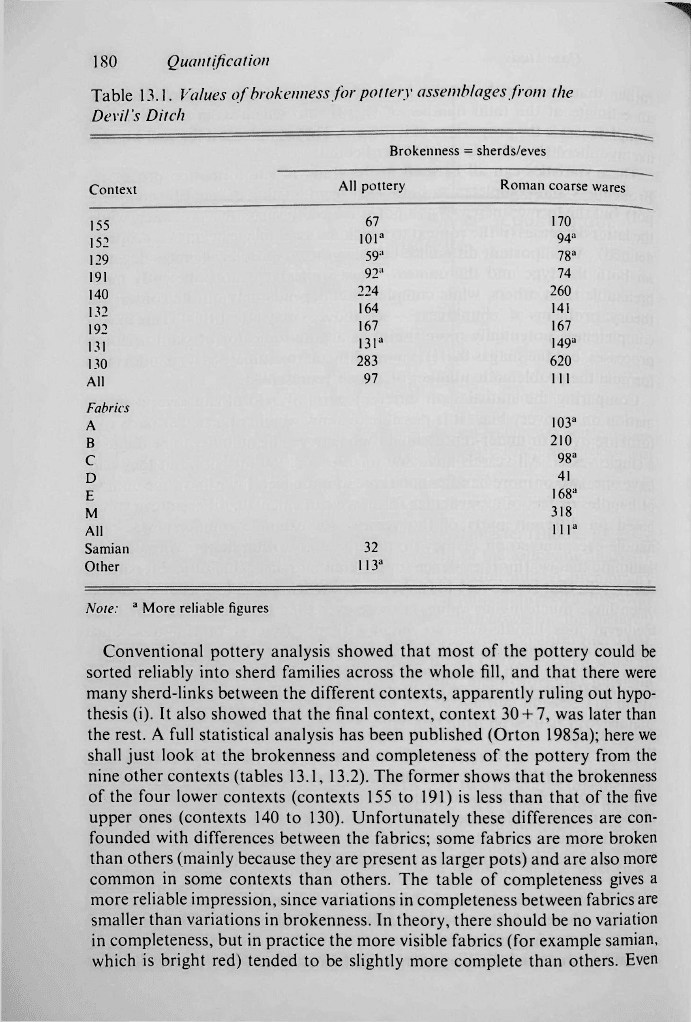
180 Quantification
Table 13.1. Values of brokenness for pottery assemblages from the
Devil's Ditch
Brokenness = sherds/eves
Context
All pottery
Roman coarse wares
155
67 170
152
fiP
94*
129
59* 78*
191
92
a
74
140
224
260
132
164 141
192
167
167
131
13I
a
149
а
130
283
620
All
97
11:1
Fabrics
A
103*
B
210
C
98*
D
41
E
168*
M
318
All
111*
Samian
32
Other
113
a
Note:
a
More reliable figures
Conventional pottery analysis showed that most of the pottery could be
sorted reliably into sherd families across the whole fill, and that there were
many sherd-links between the different contexts, apparently ruling out hypo-
thesis (i). It also showed that the final context, context 30 + 7, was later than
the rest. A full statistical analysis has been published (Orton 1985a); here we
shall just look at the brokenness and completeness of the pottery from the
nine other contexts (tables 13.1,13.2). The former shows that the brokenness
of the four lower contexts (contexts 155 to 191) is less than that of the five
upper ones (contexts 140 to 130). Unfortunately these differences are con-
founded with differences between the fabrics; some fabrics are more broken
than others (mainly because they are present as larger pots) and are also more
common in some contexts than others. The table of completeness gives a
more reliable impression, since variations in completeness between fabrics are
smaller than variations in brokenness. In theory, there should be no variation
in completeness, but in practice the more visible fabrics (for example samian,
which is bright red) tended to be slightly more complete than others. Even
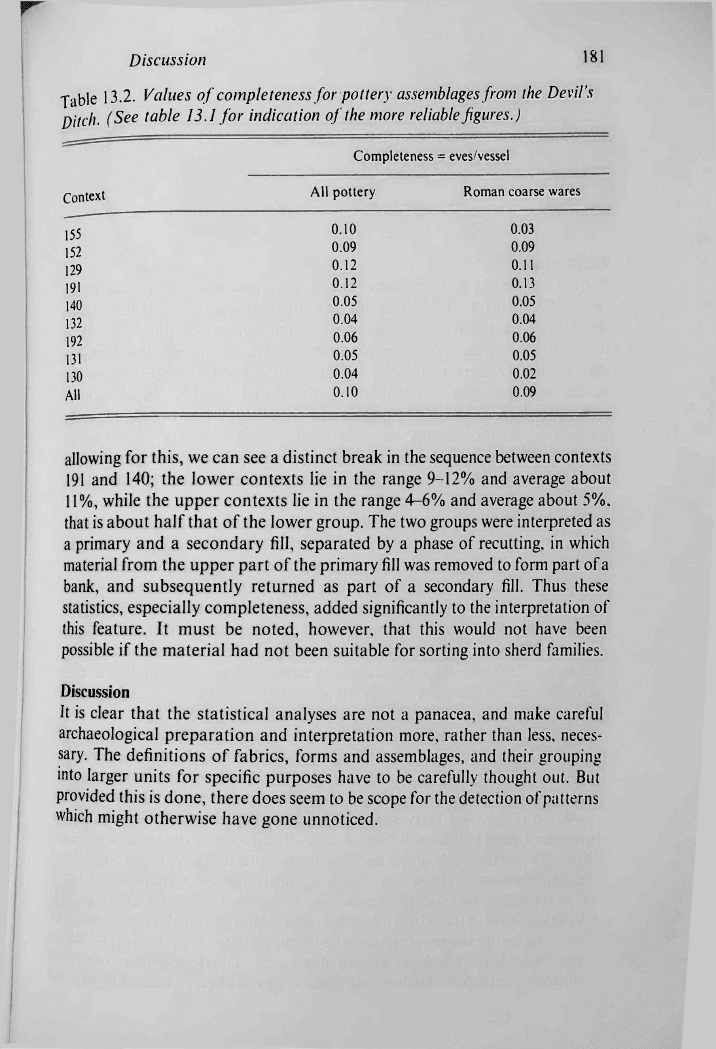
Discussion
181
Table 13,2. Values of completeness for pottery assemblages from the Devil's
Ditch-
(See table
13.1
for indication of
the
more
reliable
figures.)
Completeness = eves/vessel
Context
All pottery Roman coarse wares
155
0.10
0.03
152
0.09
0.09
129
0.12
0.11
191
0.12 0,13
140
0.05 0.05
132
0.04 0.04
192
0.06 0.06
131
0.05
0.05
130
0.04 0.02
All
0.10
0.09
allowing for this, we can see a distinct break in the sequence between contexts
191 and 140; the lower contexts he in the range 9-12% and average about
11%, while the upper contexts lie in the range 4-6% and average about 5%,
that is about half that of the lower group. The two groups were interpreted as
a primary and a secondary fill, separated by a phase of recutting, in which
material from the upper part of the primary fill was removed to form part of a
bank, and subsequently returned as part of a secondary fill. Thus these
statistics, especially completeness, added significantly to the interpretation of
this feature. It must be noted, however, that this would not have been
possible if the material had not been suitable for sorting into sherd families.
Discussion
It is clear that the statistical analyses are not a panacea, and make careful
archaeological preparation and interpretation more, rather than less, neces-
sary. The definitions of fabrics, forms and assemblages, and their grouping
into larger units for specific purposes have to be carefully thought out. But
provided this is done, there does seem to be scope for the detection of patterns
which might otherwise have gone unnoticed.
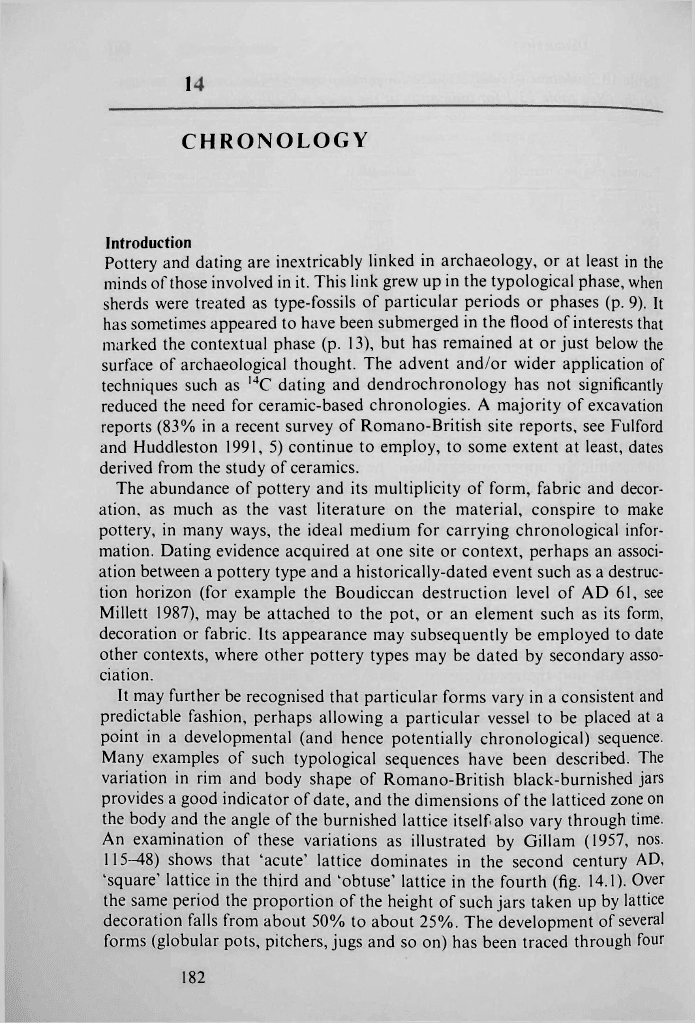
17
CHRONOLOGY
Introduction
Pottery and dating are inextricably linked in archaeology, or at least in the
minds of those involved in it. This link grew up in the typological phase, when
sherds were treated as type-fossils of particular periods or phases (p. 9). It
has sometimes appeared to have been submerged in the flood of interests that
marked the contextual phase (p. 13), but has remained at or just below the
surface of archaeological thought. The advent and/or wider application of
techniques such as
14
C dating and dendrochronology has not significantly
reduced the need for ceramic-based chronologies. A majority of excavation
reports (83% in a recent survey of Romano-British site reports, see Fulford
and Huddleston 1991, 5) continue to employ, to some extent at least, dates
derived from the study of ceramics.
The abundance of pottery and its multiplicity of form, fabric and decor-
ation, as much as the vast literature on the material, conspire to make
pottery, in many ways, the ideal medium for carrying chronological infor-
mation. Dating evidence acquired at one site or context, perhaps an associ-
ation between a pottery type and a historically-dated event such as a destruc-
tion horizon (for example the Boudiccan destruction level of AD 61, see
Millett 1987), may be attached to the pot, or an element such as its form,
decoration or fabric. Its appearance may subsequently be employed to date
other contexts, where other pottery types may be dated by secondary asso-
ciation.
It may further be recognised that particular forms vary in a consistent and
predictable fashion, perhaps allowing a particular vessel to be placed at a
point in a developmental (and hence potentially chronological) sequence.
Many examples of such typological sequences have been described. The
variation in rim and body shape of Romano-British black-burnished jars
provides a good indicator of date, and the dimensions of the latticed zone on
the body and the angle of the burnished lattice itself also vary through time.
An examination of these variations as illustrated by Gillam (1957, nos.
115-48) shows that 'acute' lattice dominates in the second century AD,
'square' lattice in the third and 'obtuse' lattice in the fourth (fig. 14.1). Over
the same period the proportion of the height of such jars taken up by lattice
decoration falls from about 50% to about 25%. The development of several
forms (globular pots, pitchers, jugs and so on) has been traced through four
182

Introduction
^ /
^ KM black-burnished ware jars
showing .he
of ktt
№
- .
- :
m S» . ' . , % tn within
AD 12U-10U,
nos.
.
..x.
ocicuiea DiacK-burnished ware jars snowing
me
^ r nn-if>0 nos 141-2
H
burnishing.
Nos. 115-17 (acute lattice) are dated to
w.thm AD
120-160, «^
»re lattice) to within AD 160-280 and
nos. 146-8
(obtuse
latt.ee) to
within
AD
^
lllam
^57, nos. 115-17, 141-2, 146-8)
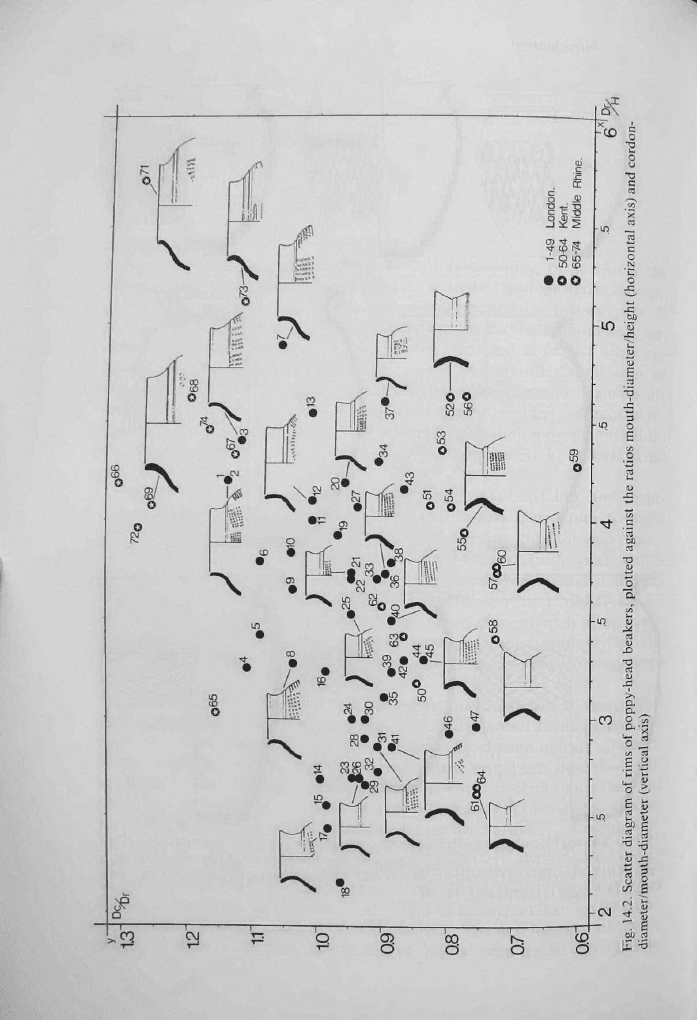
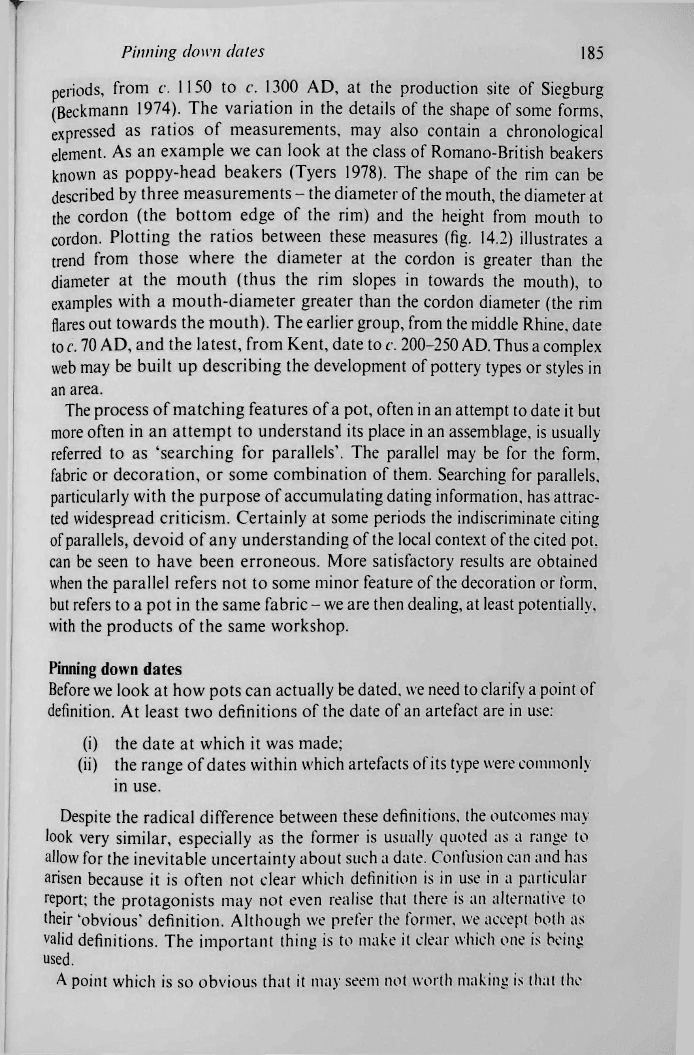
Pinning down dates
185
periods, from c. 1150 to c. 1300 AD, at the production site of Siegburg
(Beckmann 1974). The variation in the details of the shape of some forms,
expressed as ratios of measurements, may also contain a chronological
element. As an example we can look at the class of Romano-British beakers
known as poppy-head beakers (Tyers 1978). The shape of the rim can be
described by three measurements - the diameter of the mouth, the diameter at
the cordon (the bottom edge of the rim) and the height from mouth to
cordon. Plotting the ratios between these measures (fig. 14.2) illustrates a
trend from those where the diameter at the cordon is greater than the
diameter at the mouth (thus the rim slopes in towards the mouth), to
examples with a mouth-diameter greater than the cordon diameter (the rim
flares out towards the mouth). The earlier group, from the middle Rhine, date
to c. 70
AD, and the latest, from Kent, date to
c.
200-250
AD.
Thus a complex
web may be built up describing the development of pottery types or styles in
an area.
The process of matching features of a pot, often in an attempt to date it but
more often in an attempt to understand its place in an assemblage, is usually
referred to as 'searching for parallels'. The parallel may be for the form,
fabric or decoration, or some combination of them. Searching for parallels,
particularly with the purpose of accumulating dating information, has attrac-
ted widespread criticism. Certainly at some periods the indiscriminate citing
of parallels, devoid of any understanding of the local context of the cited pot,
can be seen to have been erroneous. More satisfactory results are obtained
when the parallel refers not to some minor feature of the decoration or form,
but
refers
to a pot in the same fabric - we are then dealing, at least potentially,
with the products of the same workshop.
Pinning down dates
Before
we look at how pots can actually be dated, we need to
clarify
a point of
definition. At least two definitions of the date of an artefact are in use:
(i) the date at which it was made;
(ii) the range of dates within which artefacts of its type were commonly
in use.
Despite the radical difference between these definitions, the outcomes may
look very similar, especially as the former is usually quoted as a range to
allow for the inevitable uncertainty about such a date. Confusion can and has
arisen because it is often not clear which definition is in use in a particular
report; the protagonists may not even realise that there is an alternative to
their 'obvious' definition. Although we prefer the former, we accept both as
valid definitions. The important thing is to make it clear which one is being
used.
A point which is so obvious that it may seem not worth making is that the

186 Chronology
Fig. 14.3. Example of a vessel inscribed with its date of manufacture: a cup from Colonial
Williamsburg dated 1660, commemorating the restoration of Charles II. (Photo: Colonial
Williamsburg Foundation)
date of a pot or a sherd is not necessarily the date of the archaeological
context in which it was found. Apart from the problem of the life-expectancy
of different vessels types (p. 207), whose effect will depend on the definition
of
date (see above), there is the question of the post-depositional history of the
pottery. Between its original breakage and/or discard and its final resting
place, it may have undergone several events (such as sweeping-up, removal to
a rubbish pit, disturbance of that pit, and so on) spread over several years or
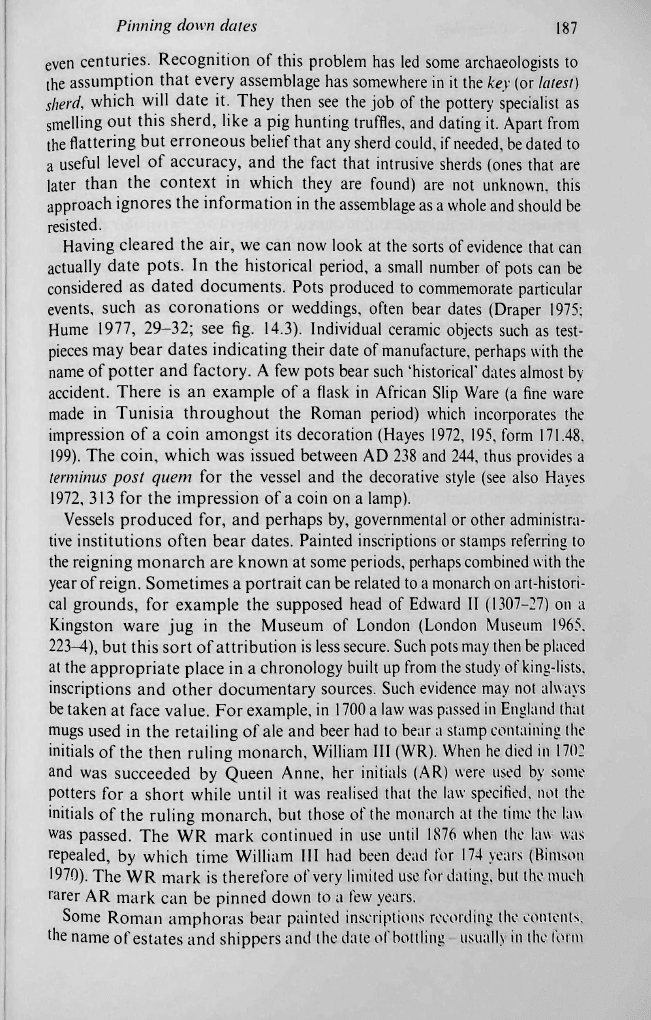
Pinning down dates
187
even centuries. Recognition of this problem has led some archaeologists to
the assumption that every assemblage has somewhere in it the key (or latest)
sherd,
which will date it. They then see the job of the pottery specialist as
smelling out this sherd, like a pig hunting
truffles,
and dating it. Apart from
the flattering but erroneous belief that any sherd could, if needed, be dated to
a useful level of accuracy, and the fact that intrusive sherds (ones that are
later than the context in which they are found) are not unknown, this
approach ignores the information in the assemblage as a whole and should be
resisted.
Having cleared the air, we can now look at the sorts of evidence that can
actually date pots. In the historical period, a small number of pots can be
considered as dated documents. Pots produced to commemorate particular
events, such as coronations or weddings, often bear dates (Draper 1975;
Hume 1977, 29-32; see fig. 14.3). Individual ceramic objects such as test-
pieces may bear dates indicating their date of
manufacture,
perhaps with the
name of potter and factory. A few pots bear such 'historical' dates almost by
accident. There is an example of a flask in African Slip Ware (a fine ware
made in Tunisia throughout the Roman period) which incorporates the
impression of a coin amongst its decoration (Hayes 1972, 195, form 171.48,
199). The coin, which was issued between AD 238 and 244, thus provides a
terminus
post quem for the vessel and the decorative style (see also Hayes
1972, 313 for the impression of a coin on a lamp).
Vessels produced for, and perhaps by, governmental or other administra-
tive institutions often bear dates. Painted inscriptions or stamps referring to
the reigning monarch are known at some periods, perhaps combined with the
year of reign. Sometimes a portrait can be related to a monarch on art-histori-
cal grounds, for example the supposed head of Edward II (1307-27) on a
Kingston ware jug in the Museum of London (London Museum 1965,
223-4), but this sort of attribution is less secure. Such pots may then
be
placed
at the appropriate place in a chronology built up from the study of king-lists,
inscriptions and other documentary sources. Such evidence may not always
be
taken at face value. For example, in 1700 a law was passed in England that
mugs used in the retailing of ale and beer had to bear a stamp containing the
initials of the then ruling monarch, William III (WR). When he died in 1702
and was succeeded by Queen Anne, her initials (AR) were used by some
potters for a short while until it was realised that the law specified, not the
initials of the ruling monarch, but those of the monarch at the time the law
was passed. The WR mark continued in use until 1876 when the law was
repealed, by which time William III had been dead for 174 years (Bimson
1970). The WR mark is therefore of very limited use
for
dating, but the much
rarer AR mark can be pinned down to a few years.
Some Roman amphoras bear painted inscriptions recording the contents,
the name of estates and shippers and the date of bottling - usually in the form
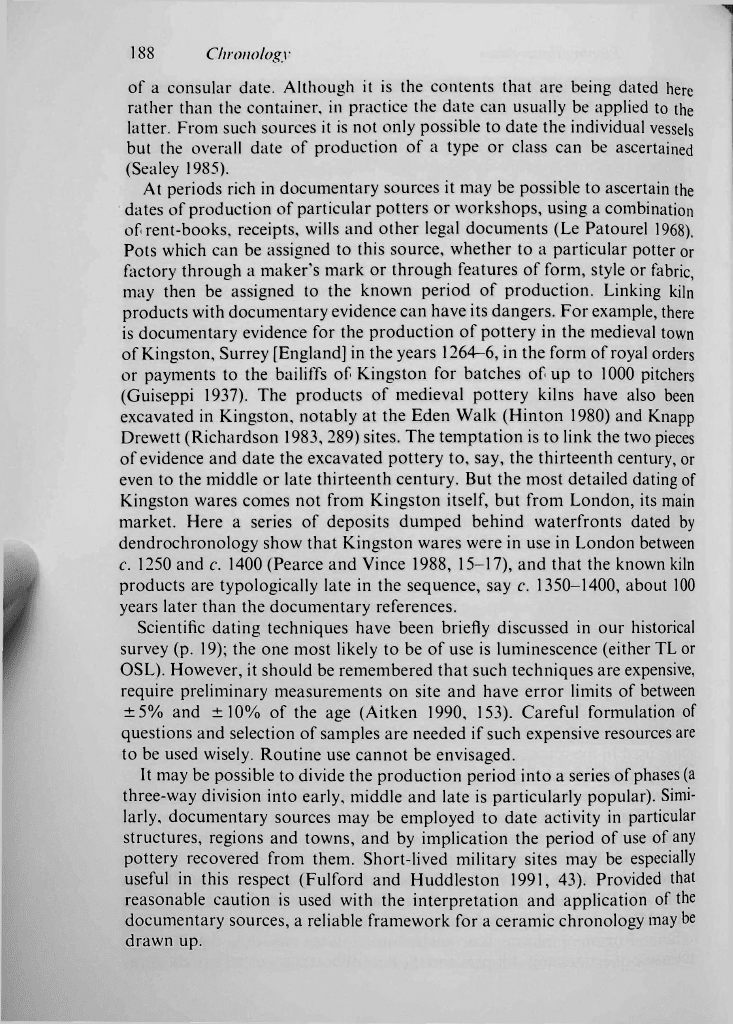
188 Chronology
of a consular date. Although it is the contents that are being dated here
rather than the container, in practice the date can usually be applied to the
latter. From such sources it is not only possible to date the individual vessels
but the overall date of production of a type or class can be ascertained
(Sealey 1985).
At periods rich in documentary sources it may be possible to ascertain the
dates of production of particular potters or workshops, using a combination
of rent-books, receipts, wills and other legal documents (Le Patourel 1968).
Pots which can be assigned to this source, whether to a particular potter or
factory through a maker's mark or through features of form, style or fabric,
may then be assigned to the known period of production. Linking kiln
products with documentary evidence can have its dangers. For example, there
is documentary evidence for the production of pottery in the medieval town
of Kingston, Surrey [England] in the years 1264-6, in the form of royal orders
or payments to the bailiffs of Kingston for batches of up to 1000 pitchers
(Guiseppi 1937). The products of medieval pottery kilns have also been
excavated in Kingston, notably at the Eden Walk (Hinton 1980) and Knapp
Drewett (Richardson 1983,289) sites. The temptation is to link the two pieces
of evidence and date the excavated pottery to, say, the thirteenth century, or
even to the middle or late thirteenth century. But the most detailed dating of
Kingston wares comes not from Kingston itself, but from London, its main
market. Here a series of deposits dumped behind waterfronts dated by
dendrochronology show that Kingston wares were in use in London between
c. 1250 and c. 1400 (Pearce and Vince 1988, 15-17), and that the known kiln
products are typologically late in the sequence, say c, 1350-1400, about 100
years later than the documentary references.
Scientific dating techniques have been briefly discussed in our historical
survey (p. 19); the one most likely to be of use is luminescence (either TL or
OSL). However, it should be remembered that such techniques are expensive,
require preliminary measurements on site and have error limits of between
±5% and ±10% of the age (Aitken 1990, 153). Careful formulation of
questions and selection of samples are needed if such expensive resources are
to be used wisely. Routine use cannot be envisaged.
It may be possible to divide the production period into a series of phases (a
three-way division into early, middle and late is particularly popular). Simi-
larly, documentary sources may be employed to date activity in particular
structures, regions and towns, and by implication the period of use of any
pottery recovered from them. Short-lived military sites may be especially
useful in this respect (Fulford and Huddleston 1991, 43). Provided that
reasonable caution is used with the interpretation and application of the
documentary sources, a reliable framework for a ceramic chronology may be
drawn up.
